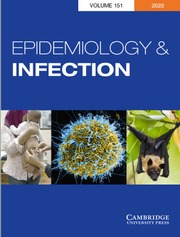Crossref Citations
This article has been cited by the following publications. This list is generated based on data provided by
Crossref.
Koopmans, Marion
2005.
Outbreaks of viral gastroenteritis: what??s new in 2004?.
Current Opinion in Internal Medicine,
Vol. 4,
Issue. 5,
p.
482.
Okada, Mineyuki
Ogawa, Tomoko
Kaiho, Ikuo
and
Shinozaki, Kuniko
2005.
Genetic Analysis of Noroviruses in Chiba Prefecture, Japan, between 1999 and 2004.
Journal of Clinical Microbiology,
Vol. 43,
Issue. 9,
p.
4391.
Vasickova, P.
Dvorska, L.
Lorencova, A.
and
Pavlik, I.
2005.
Viruses as a cause of foodborne diseases: a review of the literature.
Veterinární medicína,
Vol. 50,
Issue. 3,
p.
89.
Koopmans, Marion
2005.
Outbreaks of viral gastroenteritis: whatʼs new in 2004?.
Current Opinion in Infectious Diseases,
Vol. 18,
Issue. 4,
p.
295.
Ward, Richard L.
Jiang, Xi
Farkas, Tibor
and
Bass, Dorsey M.
2006.
Mucosal Immunology and Virology.
p.
55.
Masago, Yoshifumi
Katayama, Hiroyuki
Watanabe, Toru
Haramoto, Eiji
Hashimoto, Atsushi
Omura, Tatsuo
Hirata, Tsuyoshi
and
Ohgaki, Shinichiro
2006.
Quantitative Risk Assessment of Noroviruses in Drinking Water Based on Qualitative Data in Japan.
Environmental Science & Technology,
Vol. 40,
Issue. 23,
p.
7428.
Colquhoun, David R.
Schwab, Kellogg J.
Cole, Robert N.
and
Halden, Rolf U.
2006.
Detection of Norovirus Capsid Protein in Authentic Standards and in Stool Extracts by Matrix-Assisted Laser Desorption Ionization and Nanospray Mass Spectrometry.
Applied and Environmental Microbiology,
Vol. 72,
Issue. 4,
p.
2749.
Cashdollar, Jennifer L.
and
Dahling, Daniel R.
2006.
Evaluation of a method to re-use electropositive cartridge filters for concentrating viruses from tap and river water.
Journal of Virological Methods,
Vol. 132,
Issue. 1-2,
p.
13.
Grabow, Wilhelm O.K.
2007.
Human Viruses in Water.
Vol. 17,
Issue. ,
p.
1.
Schwab, Kellogg
2007.
Human Viruses in Water.
Vol. 17,
Issue. ,
p.
27.
PODEWILS, L. J.
ZANARDI BLEVINS, L.
HAGENBUCH, M.
ITANI, D.
BURNS, A.
OTTO, C.
BLANTON, L.
ADAMS, S.
MONROE, S. S.
BEACH, M. J.
and
WIDDOWSON, M.
2007.
Outbreak of norovirus illness associated with a swimming pool.
Epidemiology and Infection,
Vol. 135,
Issue. 5,
p.
827.
Moe, Christine L.
2007.
Manual of Environmental Microbiology.
p.
222.
Maunula, Leena
2007.
Waterborne Norovirus Outbreaks.
Future Virology,
Vol. 2,
Issue. 1,
p.
101.
Doménech-Sánchez, Antonio
Olea, Francisco
and
Berrocal, Clara I.
2008.
Infecciones relacionadas con las aguas de recreo.
Enfermedades Infecciosas y Microbiología Clínica,
Vol. 26,
Issue. ,
p.
32.
Ayi, Bertha S.
and
Dworzack, David
2009.
Infections of Leisure.
p.
69.
Victoria, Matías
Guimarães, Flávia
Fumian, Tulio
Ferreira, Fabiana
Vieira, Carmen
Leite, José Paulo
and
Miagostovich, Marize
2009.
Evaluation of an adsorption–elution method for detection of astrovirus and norovirus in environmental waters.
Journal of Virological Methods,
Vol. 156,
Issue. 1-2,
p.
73.
Sinclair, R.G.
Jones, E.L.
and
Gerba, C.P.
2009.
Viruses in recreational water-borne disease outbreaks: a review.
Journal of Applied Microbiology,
Vol. 107,
Issue. 6,
p.
1769.
Jones, Ellen L.
Gaither, Marlene
Kramer, Adam
and
Gerba, Charles P.
2009.
An Analysis of Water Quality in the Colorado River, 2003–04; An Investigation Into Recurring Outbreaks of Norovirus Among Rafters.
Wilderness & Environmental Medicine,
Vol. 20,
Issue. 1,
p.
6.
La Rosa, Giuseppina
Pourshaban, Manoochehr
Iaconelli, Marcello
and
Muscillo, Michele
2009.
Quantification of Norovirus Genogroups I and II in Environmental and Clinical Samples Using TaqMan Real-Time RT-PCR.
Food and Environmental Virology,
Vol. 1,
Issue. 1,
p.
15.
BAERT, L.
UYTTENDAELE, M.
STALS, A.
VAN COILLIE, E.
DIERICK, K.
DEBEVERE, J.
and
BOTTELDOORN, N.
2009.
Reported foodborne outbreaks due to noroviruses in Belgium: the link between food and patient investigations in an international context.
Epidemiology and Infection,
Vol. 137,
Issue. 3,
p.
316.

